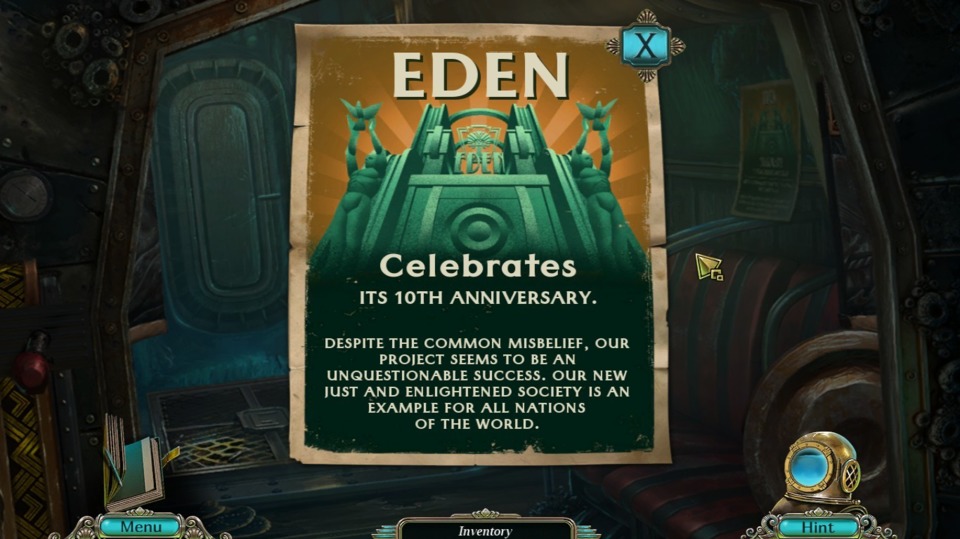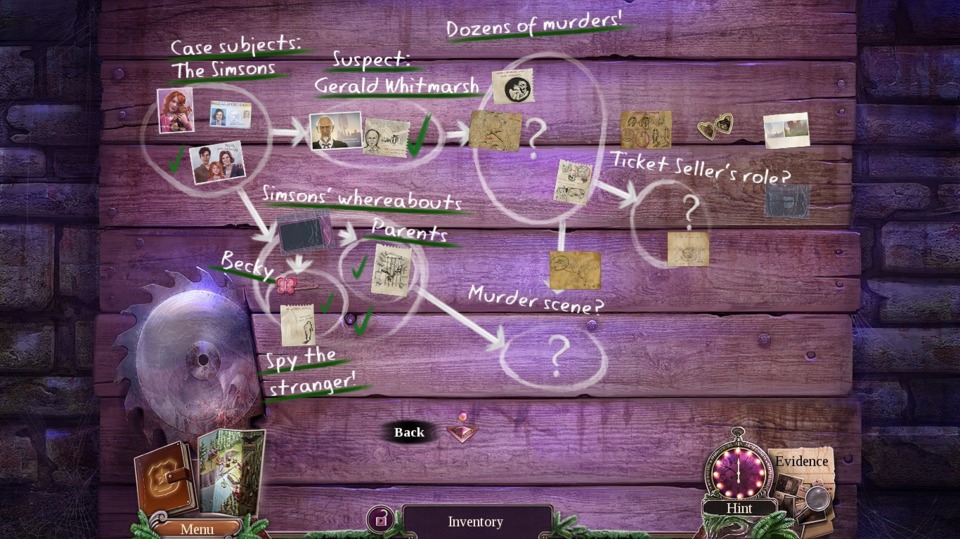Rainy Days and Mundis New Year's Eve Special: Manic Mundis
By Mento 0 Comments
That's right, H.O.Pals, I'm back on my concealed paraphernalia bullshit once again to close out the year! For those unfamiliar with this series, I began 2018 looking into what we genre experts have been calling H.O.P.A.s: Hidden Object Puzzle Adventures. A step or two above the usual hidden object fare, HOPAs supplement the traditional tableaus of assorted crap to pick through with some Layton-esque brainteasers and a whole lot of simple inventory puzzles. It's the adventure game boiled down to its core concepts, coasting by on generic pap for its storytelling and providing a similar mix of puzzle types each time for casual fans of melon-scratching to befuddle their way through.
When I finished (sorry, "finished") the feature back in March with the sixth entry (which has links to the previous five), I had already passed the point of finding its recycled themes and puzzles, its low animation quality, and their insistence on the same interface and first-person perspective charming. I started seeing these games for what they were: identikit constructs pieced together by a random assortment of mostly pre-used assets, given a fresh coat of paint from the Kinkaid-ish artists under their employ, and dropped onto the unsuspecting Steam, iOS and Android marketplaces every few months. Artifex Mundi - after which this feature was named - is one of the better HOPA-peddlers out there, but it's remarkable how many games from them, their subsidiaries and their rivals alike are functionally identical. It makes me wonder two things: A) if a company who wants in on this action really wants to set themselves apart, why hasn't a single company ever even attempted to innovate on the blueprint (besides some facile quality-of-life improvements like fast-travel)? and B) is there an Ur example of this particular format from which all others are born? I've noted before now that the structure is similar to the old Legend Entertainment adventure games, for which I have a lot of affection, but those were very specifically story-heavy variants of '90s adventure games, often drawing from various literary licenses (Terry Brooks's Shannara Chronicles, Hickman & Weiss's Death Gate Cycle, and Spider Robinson's Callahan's series) to draw in a more library-friendly crowd. The usual limit of any HOPA's narrative aspirations is to create another feisty, beautiful, resourceful female protagonist who will save the day with her can-do spirit, and maybe rip off a few movies.
But hey, I always mean to come down hard on these things and can never bring myself to follow through on the coup de grace. HOPAs occupy a specific slot in the wider game industry, and one that is very conducive to my interests as a fan of "harder" adventure games: it gets people - usually women, but let's not gender generalize (or genderalize, which is a new word I'll be sure to patent so that any sociology student can use it for a nominal fee) - who have an aversion to games and all their loud noises and explosions but love novels and applying their intellects to take the plunge on a rollicking pulp adventure story that's unlikely to test them too hard with reaction speeds and having to memorize the functionality of a modern twenty-button joypad. So what if these things are all cynically built with the same blueprint? They have their audience, and it's not unheard of for that audience to then use those as a launching point for classic Sierra or LucasFilm point and clics, or something more contemporary like What Remains of Edith Finch or Return of the Obra Dinn (two games I really ought to be playing more than these crummy HOPAs).
At any rate, after finishing Deltarune a few days ago I noticed I was three shy of hitting a grand total of 100 completed games this year (fifty Indie Games of the Week and a twenty-five-part SNES feature helped get me most of the way there, I'll admit). I wasn't going to complete Mass Effect Andromeda any time soon, and any other short Indie game in my possession was already pencilled in for next year's IGotW schedule, so... I went to that dark place. The darkest place. The special category in my Steam library I set aside for all the HOPAs I keep picking up from bundles. I booted up three with decent scores, all of which are Mundi originals, and got right back on board that wagon. For one last time:
The Tri-Hidden-Objecta (Like Trifecta but... you get it)
Abyss: The Wraiths of Eden
I had a few underwater games on standby - an oddly popular genre for hidden objects, probably because we're always dumping garbage in the ocean - but Abyss piqued my interest because it appeared to be ripping off three major franchises at once: James Cameron's The Abyss, back when he made movies about blue aliens instead of whatever it is he's doing now; Irrational Games's BioShock, in particular the underwater city of Rapture and the somewhat dubious philosophies of its founder(s); and some manner of Lovecraftian Cthulhu business in which a demonic statue with an octopus head possesses people and has them floating around doing his dark bidding. The plot summarizes itself with those influences, but I will say that it never seemed to figure out which time era this underwater city was based in. It looked '50s, like Rapture, but was full of contemporary technology in the hidden object scenes and elsewhere. I'll go ahead and assume that the people making the HO part of the game weren't talking to the story/artist people and vice versa. We'd be kidding ourselves if we thought these games weren't made in some kind of factory assembly line.

Enigmatis 2: The Mists of Ravenwood
A little bit more a supernatural detective story with a Silence of the Lambs "speak to a dangerous psycho behind bars to catch a detably even more dangerous psycho who is on the loose" vibe to it. I skipped the first Enigmatis - oh no, the rich lore - because this one had a giant bird in it. It's actually kind of a neat premise; you're searching for the serial killer that got loose after the first game, stumbling upon an eons-old battle between immortals immune to all harm except for a specific type of bladed weapon, where only one can acquire ultimate power. You have to admit, that doesn't sound like any other licensed property on Earth.

Grim Legends 3: The Dark City
For our swansong, we bring it right back around to the Grim Legends trilogy, of which the first part was where this series originally began those many moons ago. We're still hunting mythological figures in the industrial revolution era of circa 1886-ish, only now we're part of a legendary "The Order" established to protect the world from the supernatural. But I want to make it clear: it's absolutely nothing like The Order: 1886. It's actually a lot more like Assassin's Creed Syndicate, but combined with The Order: 1886. Bottom line: You're trying to slay a demon that threatens to free itself into our world, which is also what the previous two games are about. Vive la difference.

Similarity Rundown
Playing three of these things back-to-back has shone a spotlight on some very dark truths. The first of which is that I wasted New Year's Eve doing something very stupid that didn't involve alcohol for once. The second is that there are a surprising number of details that keep popping up in these games, and I'm wondering if there isn't some elaborate wiki out there that tracks all these little recurring idiosyncrasies.
For instance, all three of the above games have you encounter a knotted rope where the protagonist shrugs and says "looks pretty 'Gordian' to me!", like the developers didn't want to make a knot-untying puzzle (though many previous HOPAs have those) and just demanded you go find a knife somewhere. Coincidentally enough, each of the three games also has you wrapping a piece of broken glass with a cloth so you can use it to cut something, often the Gordian knot.
To be fair, these games are always getting you to cut something or burn something to move ahead with its puzzles, so I can forgive some repetition in that regard. The puzzle variation is where it gets a little more damning: with the exception of a single nonogram in Abyss and a couple of The Room style intricate puzzle boxes in Grim Legends 3, every puzzle type was seen multiple times either across the three games or just in one game alone. All the usual suspects are here and accounted for: sliding blocks, number squares, that one where you have to light all the objects and they keep switching off their adjacent partners, those mazes where you have to pass through each node exactly once, figuring out a safe combo by moving a dial back and forth, two variations on that water jug weight puzzle from Die Hard With a Vengeance (and I had about as much patience with them as Zeus did), light beams and mirrors, jigsaw puzzles, and a few where you have to follow a recipe to the letter to make some sort of alchemical tonic or tincture.
The most frequent, of course, were the hidden object puzzles themselves: I clocked Abyss with twenty-six (ten of which used a repeated scene), Enigmatis 2 with eighteen (with eight repeats), and Grim Legends 3 with a merciful nine (with four repeeats). However, those were just the text-based ones - the ones that give you a list, in words, of what you need to find. There's also those that give you a basic shape to look out for, and adding those brings the numbers up to thirty (Abyss), twenty-seven (Enigmatis 2), and nineteen (Grim Legends 3). If nothing else, I learn a lot of new words from struggling to figure out what the word lists are trying to convey to me: I now know what a wind rose, a honey dripper, and a samovar are, among others.
It is worth reiterating that while the repeating puzzle types are annoying - how is it Layton always manages to do fine with their variation when they have 200 puzzles to add to a game? Barring how often matchsticks and sliding blocks tend to show up - it's really the way the interface and presentations are identical too. Maybe there's comfort in familiarity, and if these games are developed for anything it's comfort.
Could just be I'm scrambling my noodle over something I'm never going to quite fully understand, as someone who is so far deep into video gaming that there's no longer any escape. I can get on board with a little bit of casual gaming every now and again, but there's something so soporific and obstinate about the way they deliver content that feels partially lazy and partially cynical, even if I'm sure deep down it's neither of those things and these developers are, in actuality, pouring their hearts and souls into the same exact game three or four times a year. Well, as I often say with anything that might require serious investigative action to suss out: let Waypoint deal with it.
That's going to do it for 2018's blogging content everyone! Expect next year to be relatively free of HOPAs as I move onto the other parts of my Steam library that haven't seen sunlight for years, rummaging through the trash to pick out the specific items that will prove to... oh god, my entire blogging strategy itself is just one giant hidden objects game. Shit. 2018 is ending on a damn Twilight Zone denouement, and how perfectly germane is that for this burning dumpster of a year.
(Happy New Year! See you in January!)
